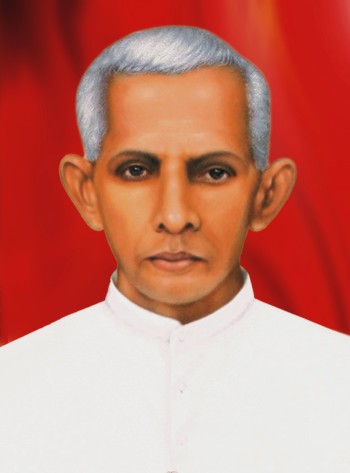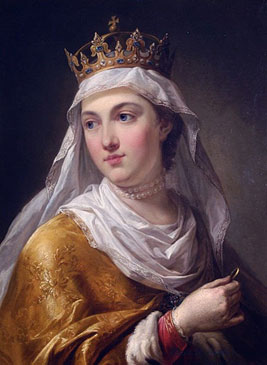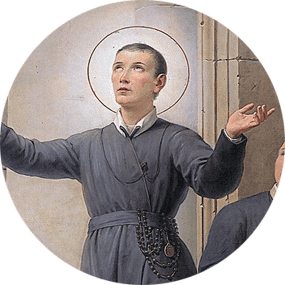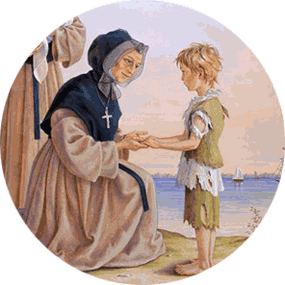16 October
St. Margaret Mary Alacoque (1647-1690)
Mystic, Leader of the devotion to the Sacred Heart of Jesus
After a girlhood marked by painful illness and even more painful family discord, Margaret Mary Alacoque (1647-1690) entered the Visitation convent of Paray-le-Monial, France, at the age of 22. She was ignorant, sickly, and clumsy, but she had great charity and humility. Our Lord chose her to spread devotion to his Sacred Heart, at a time when rebellion without (Protestantism) and heresy within (Jansenism) were doing their best to separate Catholics from their faith and their God.
Blsd Augustine Thevaraparambil (1891-1973)
Priest (Kerala, India)
Ordained a priest at 24, Fr Augustine (“Kunjachan”) is counted as one of the foremost missionaries among the Dalits in India drawing thousands of them through his loving dedication to their upliftment.
St. Hedwig (1174-1243)
Widow, Duchess of Poland
Hedwig (1174-1243), the aunt of St. Elizabeth of Hungary, was married at an early age to Henry, Duke of Silesia. After their six children had been born, they both strove to advance in sanctity and to enrich Silesia and Poland with monasteries, hospitals, and leper asylums. When Henry died in 1238, Hedwig took the habit of the Cistercian nuns at Trebnitz (where one of her daughters was the abbess), but retained the administration of her property so that she could give personal relief to the suffering.
St. Gerard Majella “The Wonderworker” (1726-1755)
Redemptorist lay-brother
St. Gerard Majella, listed in the Roman Martyrology, was a native of Muro in southern Italy. He was apprenticed to a tailor before asking to be received by the Redemptorists as a lay-brother. He continued his trade in the monastery, where he soon attracted the attention of St. Alphonsus de Liguori, who shortened his novitiate. His wonderful and well authenticated life was a series of supernatural phenomena — bilocations, reading of consciences, prophecies, multiplying of food, etc. He was canonized in 1904 and is the patron of expectant mothers and unborn children.
St. Marguerite d’Youville (1701-1771)
Foundress of the Sisters of Charity
Marguerite d’Youville is the first native Canadian to be elevated to sainthood. She founded the Sisters of Charity.

St. Margaret Mary Alacoque (1647-1690)
Mystic, Leader of the devotion to the Sacred Heart of Jesus
“I need nothing but God, and to lose myself in the heart of Jesus.” – St. Margaret Mary
“My love reigns in suffering, it triumphs in humility and enjoys itself in unity.” – Jesus to St. Margaret Mary
Born: 22 July 1647, L’Hautecour, Burgundy, France
Died: 17 October 1690, Paray-le-Monial, Burgundy, France
Canonized: 13 May 1920, Rome by Benedict XV
Feast Day: 17 October
Patron of: those suffering with polio, devotees of the Sacred Heart, loss of parents
Margaret Mary was chosen by Christ to arouse the Church to a realization of the love of God symbolized by the heart of Jesus.
Her early years were marked by sickness and a painful home situation. “The heaviest of my crosses was that I could do nothing to lighten the cross, my mother was suffering.” After considering marriage for some time, Margaret Mary entered the Order of the Visitation nuns at the age of 24.
A Visitation nun was “not to be extraordinary except by being ordinary,” but the young nun was not to enjoy this anonymity. A fellow novice termed Margaret Mary humble, simple, and frank, but above all, kind and patient under sharp criticism and correction. She could not meditate in the formal way expected, though she tried her best to give up her “prayer of simplicity.” Slow, quiet, and clumsy, she was assigned to help an infirmarian who was a bundle of energy.
On December 21, 1674, three years a nun, she received the first of her revelations. She felt “invested” with the presence of God, though always afraid of deceiving herself in such matters. The request of Christ was that his love for humankind be made evident through her.
During the next 13 months, Christ appeared to her at intervals. His human heart was to be the symbol of his divine-human love. By her own love Margaret Mary was to make up for the coldness and ingratitude of the world—by frequent and loving Holy Communion, especially on the first Friday of each month, and by an hour’s vigil of prayer every Thursday night in memory of his agony and isolation in Gethsemane. He also asked that a feast of reparation be instituted.
Like all saints, Margaret Mary had to pay for her gift of holiness. Some of her own sisters were hostile. Theologians who were called-in, declared her visions delusions and suggested that she eat more heartily. Later, parents of children she taught called her an impostor, an unorthodox innovator. A new confessor, the Jesuit Claude de la Colombière, recognized her genuineness and supported her. Against her great resistance, Christ called her to be a sacrificial victim for the shortcomings of her own sisters, and to make this known.
After serving as novice mistress and assistant superior, Margaret Mary died at the age of 43, while being anointed. She said: “I need nothing but God, and to lose myself in the heart of Jesus.”
Source: Franciscan Media
View a collection of Writings and Thoughts of St. Margaret Mary

Blsd Augustine Thevaraparambil (1891-1973)
Priest
Born 1 April 1891, Ramapuram, Kerala, India
Died 16 October 1973 (aged 82), Ramapuram, Kerala, India
Venerated in Syro Malabar Church
Beatified 30 April 2006, Ramapuram by Mar Varkey Vithayathil
Major shrine Mar Augustine’s Forane Church, Ramapuram.
Feast 16 October
Early life
Augustine was born on 1 April 1891, at Ramapuram in Travancore (present-day Kerala, India). He was the son of Itty Iype and Eliswa of the Thevarparambil clan, which was a branch of the Kuzhumpil lineage.
Augustine received his primary education at a school sponsored by the government of Travancore. He advanced to St. Ephrem’s School in Mannanam where his religious faith intensified, compelling him to pursue a career as a priest. After completing in secondary education at St Ephrem’s School, Augustine embarked on a jounery on foot from Ramapuram to Changanacherry in order to enroll in St Thomas Minor Seminary. After receiving his major seminary formation at Puthenpally Seminary in Varapuzha, Augustine was ordained as a priest on July 16, 1915.
Early career
After celebrating his first Mass at St. Augustine Church in Ramapuram, his home parish, Augustine resided in his home village for eight years while undergoing practical training. He was known as Kunjachan (‘little priest’ in Malayalam) for his short stature. In 1923, Augustine was appointed as assistant vicar to Thomas Kuzhumpil at St. Sebastian Church in Kadanad.
During his vocation in Kadanad, Kunjachan was often approached by the local villagers, who relied on his advice and blessings for their agricultural yield. Kunjachan would sprinkle holy water on crops, ensuring a plentiful harvest. Unfortunately, an illness forced Kunjachan to return to Ramapuram.
Missionary work
In Ramapuram, Kunjachan witnessed an entire caste of people deprived of dignity, respect, and the basic necessities of life. He would devote his entire life to the uplifting of the downtrodden. It is the singular achievement of Kunjachan that he had been able to baptize by himself no less than 5,000 Dalits (earlier the term ‘Harijan’ was used). In fact, he neither made use of eloquent sermons nor of any human techniques in order to give them the “Christ” of whom he was the herald. He preached with his works, practising charity, and always sublime and more dedicated.
Kunjachan led a very simple life for the poor and wished to be with them even after death. He spent everything he had for the poor. The Blessed who was a priest for more than 50 years, wrote in his Testament:
“I do not possess anything either as landed property or as cash account… After my death, my funeral must be conducted in the most simple way. Ever since 1926, I had been staying with the Harijan (Dalit) Christians. Even after death, I would like to be with them. Therefore my dead body should be buried where the Harijan Christians are buried”.
Death
After a brief period of serious illness Kunjachan died on 16 October 1973 at the age of 82. At his death the children and others told that ‘a saint has passed away’. At his funeral the priest who preached the panegyric, spoke well of his holiness in life, apostolic zeal, kindness of heart, love for the poor and other outstanding virtues. And towards the end of the speech he said to the surprise of all, “we are participating in the funeral of a saint. We have one more mediator in heaven.”
Kunjachan had the reputation of a holy man even while he was alive. People irrespective of caste and religion, used to approach him in their manifold needs and they got favors through his prayers and blessings. Within a few days after his death his tomb at Ramapuram became a center of pilgrimage for people from far and wide.
Beatification and canonization
Beatified by Varkey Vithayathil, Major Archbishop of the Syro-Malabar Church on 30 April 2006.Participated by Papal Nuncio to India Archbishop Pedro Lopez Quintana and Cardinal Telesphore Toppo, President of the Catholic Bishops Conference of India (CBCI).
The process of beatification and canonization started on 11 August 1987 at Ramapuram, bestowing upon him the title, ‘Servant of God’. The ‘Positio super vita et virtutibus’ was completed after ten years and was submitted at the Congregation for the Causes of Saints on 12 February 1997. The ‘positio’ on the heroic practice of virtues of the saintly priest was approved by Pope John Paul II on 22 June 2004 and he was declared ‘The Venerable’.
Meanwhile, the process of the miraculous cure of the clubfoot of a boy, Gilson Varghese, was undertaken, and the findings were sent to Rome for consideration. After a thorough investigation of the miraculous nature of the cure, made by personnel in Rome, Pope Benedict XVI approved it, opening the way for beatification. Kunjachan was beatified by Cardinal Varkey Vithayathil, Major Archbishop of the Syro-Malabar Church on 30 April 2006 at the very same village Ramapuram where he was born, worked, died and buried.
The Papal Nuncio to India Archbishop Pedro López Quintana, Cardinal Telesphore Toppo, President of the Catholic Bishops Conference of India (CBCI), and other bishops and priests participated in the ceremony.
The Feast of Blessed Kunjachan is celebrated on 16 October every year.
Source: Wikipedia

St. Hedwig (1174-1243)
Widow, Duchess of Poland
Born: 1174 in Bavaria
Died: October 1243 at Trebnitz
Canonized: 1266 by Pope Clement IV
Patron of: Bavaria; Berlin, Germany; brides; duchesses; death of children; difficult marriages; Görlitz, Germany, diocese of; Silesia; victims of jealousy; widows
Hedwig was born in 1174 in Bavaria, the daughter of the Duke of Croatia. She was the maternal aunt of St. Elizabeth of Hungary. She married Duke Henry of Silesia and raised seven children, with the boys being quite a handful. She outlived all but one of her children, Gertrude. Hedwig persuaded her husband to use her dowry to found a Cisterian monastery for nuns at Trebnitz. Their daughter Gertrude later became abbess of the monastery.
Hedwig led a life of piety and solicitude for the sick and poor, including their religious education. She lived a life of poverty and humility, despite her prominent position. Every day, even in winter, she would walk barefooted, so her feet were in bad shape. A story tells us her husband sent her a pair of shoes, insisting that she not be without them — so she kept them under her arm. After the death of her husband Hedwig completely renounced the world and entered the monastery of Trebnitz which she had founded. She died on October 15, 1243 and is venerated as patroness of Poland. She is not to be confused with St. Hedwig, Queen of Poland (1371-1399), canonized by John Paul II. (Her feast day is February 28.)
Patron: Bavaria; brides; duchesses; death of children; marital problems; Silesia; victims of jealousy; widows.
Things to Do:
- On this feast in Poland, there is a bread called Hedwigsohlen (Shoe Soles of St. Hedwig) that used to be distributed to the poor of Trebnitz on her feast day. The shoe soles remind us of her generosity to the poor, and the fact that she sacrificed her own comfortable shoes in walking to church. A recipe can be found in Cooking with the Saints by Ernest Schuegraf, but any recipe for a bread that can be formed into a specific shape can be used. Form them into soles of shoes.
- One of the great Eastern Europe/Slovakian (including Polish) traditions is the colored Easter eggs, or pisanki (pysanky — multiple-colored eggs) and krashanki (single colored eggs). These eggs seem to have been associated with burial customs and the oldest written knowledge connects St. Hedwig with this custom. After her canonization in 1267 this miracle was attributed to Hedwig:
When the son of a prominent judge was still unable to walk at eight years of age, his mother brought the boy to the grave of St. Hedwig in her arms and was praying to St. Hedwig to heal him when, lo!, a miracle happened. In the presence of the priest who baptized him and the abbess of the monastery, the boy suddenly stood up, took an egg that lay before him and walked around the saint’s grave. The abbess took other decorated eggs and threw them at the feet of the young boy, compelling him to walk further from the tomb. This miracle is said to have happened near Easter between 1274 and 1287 (p. 107, Polish Customs, Traditions, & Folklore by Sophie Hodorowicz Knab). - Find out more about these Easter eggs, and try your hand at making these works of art.
- October is harvest time all over the world, but especially in Poland. Late September usually brings frost, so usually only the root crops, like cabbage, turnips, beets and carrots are remaining to be harvested. Old Polish legends talk about harvesting these late root crops and sowing of winter wheat on or just after October 15 which is St. Hedwig’s Day or Sw. Jadwiga in Poland. It is said that she sweetens these crops if they are left till then. See Polish Customs, Traditions, & Folklore by Sophie Hodorowicz Knab for more details.
Source: Catholic Culture

St. Gerard Majella
“The Wonderworker”
(1726-1755)
Redemptorist lay-brother
Born: April 6, 1726, southern Italy
Died: October 16, 1755
Canonized: 11 December 1904, by Pope Pius X at St. Peter’s, Rome
Patron: Childbirth; children; expectant mothers; falsely accused people; good confessions; lay brothers; motherhood; mothers; pregnant women; pro-life movement; unborn children.
St. Gerard was born in southern Italy on April 6, 1726. His father died while Gerard was still young, forcing him to be apprenticed to a tailor. His frail health, quiet disposition, and gentle ways led him to being bullied by fellow workers and by his employers.
He was refused admission to the Capuchin Order on account of his youth, so he lived for a time as a hermit. His great love for Jesus crucified caused him to lead a very ascetical lifestyle. Getting to know the Redemptorists, he applied to them but was initially rejected because of his poor health. On his insisting, however, he was reluctantly accepted and sent to the novitiate with a note saying: “I am sending you a useless lay brother.”
Gerard was professed in July 1752, and quickly disproved the prediction of his uselessness by his excellent service as porter, tailor, and sacristan. His prayerfulness and dedication began to be too great to overlook and so he gained a reputation for sanctity. This brought a large number of persons to him for guidance in the spiritual life. He readily responded, revealing a remarkable gift for sensing the deep interior reality of a person. Because of this genius, of his ability to bring relief to the sick, and of his care for women in childbirth, many miracles were attributed to him and he gained the nickname “The Wonderworker.”
His popularity eventually led to accusations of sexual misconduct, which he bore patiently until they were proven false.
He died on October 16, 1755, worn out by his austerities and by tuberculosis. Very many Catholics throughout the world honor him as the special patron of new mothers and of families, and his reputation as “The Wonderworker” continues to our day. — The Redemptorists
Things to Do:
- Read a detailed version of the life of St. Gerard here.
- If you live close to Trenton, NJ make a pilgrimage to the National Shrine of St. Gerard where an annual procession is held on his feast day or you can pay a virtual visit to the website.
Source: Catholic Culture

St. Marguerite d’Youville (1701-1771)
Foundress of the Sisters of Charity
Born: 15 October 1701, Varennes, Quebec
Died: 23 December 1771, Montreal, Canada
Canonized: 9 December 1990, by Pope John Paul II
Major Shrine: Chapel of St. Marie Marguerite d’Youville, near Montreal
Patron of: Against death of children, difficult marriages, in-law problems, loss of parents, opposition of Church authorities, people ridiculed for piety, victims of adultery, victims of unfaithfulness, widows
Marguerite d’Youville, the first native Canadian to be elevated to sainthood, was born October 15, 1701 at Varennes, Quebec. She was the eldest child born to Christophe Dufrost de Lajemmerais and Marie-Renée Gaultier. Her father died when she was seven years old leaving this family of six in great poverty. It was only through the influence of her great grandfather, Pierre Boucher, that she was enabled to study for two years at the Ursulines in Quebec. Upon her return home, she became an invaluable support to her mother and undertook the education of her brothers and sisters.
She married François d’Youville in 1722 and the young couple made their home with his mother who made life miserable for her daughter-in-law. She soon came to realize that her husband had no interest in making a home life. His frequent absences and illegal liquor trading with the Indians caused her great suffering. She was pregnant with her sixth child when François became seriously ill. She faithfully cared for him until his death in 1730. By age 29, she had experienced desperate poverty and suffered the loss of her father and husband. Four of her six children had died in infancy.
In all these suffering Marguerite grew in her belief of God’s presence in her life and of his tender love for every human person. She, in turn, wanted to make known his compassionate love to all. She undertook many charitable works with complete trust in God, who she loved as a Father.
She provided for the education of her two sons, who later became priests, and she welcomed a blind woman into her home. Marguerite was soon joined by three young women who shared her love and concern for the poor. On December 31, 1737, they consecrated themselves to God and promised to serve him in the person of the poor. Marguerite, without even realizing it, had become the foundress of the Sisters of Charity of Montreal, “Grey Nuns”.
Marguerite always fought for the rights of the poor and broke with the social conventions of her day. It was a daring move that made her the object of ridicule and taunts by her own relatives and neighbors. She persevered in caring for the poor despite many obstacles. She was in weakened health and mourning the death of one of her companions when a fire destroyed their home. This only served to deepen her commitment to the poor. On February 2, 1745, she and her two early companions pledged themselves to put everything in common in order to help a greater number of persons in need. Two years later, this “mother of the poor” as she was called, was asked to become director of the Charon Brothers Hospital in Montreal which was falling into ruin. She and her sisters rebuilt the hospital and cared for those in most desperate human misery. With the help of her sisters and their lay collaborators, Marguerite laid the foundation for service to the poor of a thousand faces.
In 1765 a fire destroyed the hospital but nothing could destroy Marguerite’s faith and courage. She asked her sisters and the poor who lived at the hospital, to recognize the hand of God in this disaster and to offer him praise. At the age of 64 she undertook the reconstruction of this shelter for those in need. Totally exhausted from a lifetime of self-giving, Marguerite died on December 23, 1771 and will always be remembered as a loving mother who served Jesus Christ in the poor.
Marguerite was one woman, but this daughter of the Church had a vision of caring for the poor that has spread far and wide. Her sisters have served on almost every continent. Today, her mission is courageously carried on in a spirit of hope by the Sisters of Charity of Montreal, “Grey Nuns” and their sister communities: the Sisters of Charity of St. Hyacinthe, the Sisters of Charity at Ottawa, the Sisters of Charity of Quebec, the Grey Nuns of the Sacred Heart (Philadelphia) and the Grey Sisters of the Immaculate Conception (Pembroke).
Excerpted from Evangelizo.org
Source: Catholic Culture